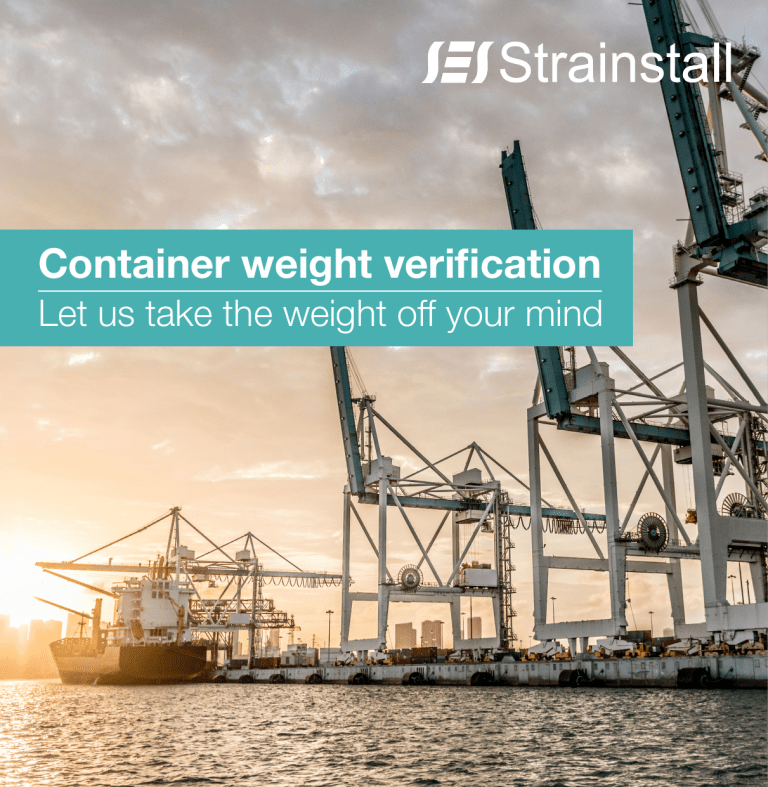
Container weight verification Let us take the weight off your mind CWSTM ensures full compliance to the IMO’s SOLAS amendments for container weight verification Strainstall’s Container Weight System (CWS)TM seamlessly integrates load monitoring technology onto existing container handling equipment, with no impact on operations. CWSTM is fully configurable to suit existing Terminal Operating Systems (TOS), delivering accurate weight verification data in real time, as part of the regular lifting cycle at the terminals. The system can be retrofitted into the spreader, headblock or sheaves, making it a permanent feature of the container handling equipment with minimal wear. System options are flexible including load pins, diaphragm load cells or industry standard twistlocks. Installed and tested in under two hours, the robust construction of CWSTM and it’s environmentally sealed enclosures provide a lifelong, low maintenance solution to container weighing. Developed in response to industry needs CWS™ meets the International Maritime Organization’s (IMO) proposed amendments to SOLAS safety guidelines for mandatory verification of container weight, which comes into effect 1 July 2016. In January 2007, the containership MSC Napoli suffered a structural failure and broke up off the coast of the UK. Misdeclared container weights were identified as a factor causing the structural failure. Features and benefits of CWS TM Container weight verification FAQ’s 1. What’s happening? Using our extensive knowledge and expertise in load measurement and data integration, Strainstall has developed a highly accurate method for container weight verification, that is fast and easy to install. From 1 July 2016, it will be a legal requirement for every export container to have a verified container weight as a condition for loading aboard a vessel. 2. Why is this happening? The mis-declaration of weights is a significant issue that arises in almost every trade and Features Benefits Weighs in motion as part of the ports lifting cycle No delay to port operations Retrofit solutions for all existing spreader based container handling systems Flexible integrated solution loading process occurs. Fast installation in under 2 hours Minimal downtime required 3. How can we verify the container weights? Non-consumable load pin or load cell system solutions Low maintenance costs Simple to install - no special tools or skills required Reduced installation costs Rugged, proven technology Highly efficient and reliable, reduces downtime and costs Highly accurate and consistent reliability Exceeds SOLAS requirements 12 month data logging Historic data available for analysis and insurance Single point streaming data Suitable for TOS or insurance related quotes Data output in various analogue / digital formats Compatible - data can be fed directly into TOS Wireless system options Quick installation and eliminates the risk of cable damage Identifies eccentrically loaded and overloaded containers Improved safety Simple on-site calibration Minimises future downtime and costs Easy field repairs in case of damage Minimises downtime Optional 3G / 4G modem for remote access Enables remote commissioning, operational support and upgrades Small and lightweight system with minimal power requirements Simplifies installation has led to a number of catastrophic incidents. Proper container handling and safe vessel stowage planning requires the verification of accurate container weights before the vessel The IMO’s SOLAS amendments provide two approved methods in determining the container weight: • Method 1 - weighing the loaded container • Method 2 - weighing the contents of the container and adding the weight to the containers tare weight Method 1 is the only approved way to measure liquids and flexi tanks. The IMO guidelines state that method 2 ‘would be inappropriate and impractical for certain types of cargo’ which are not easy to weigh e.g. scrap metal and unbagged grain. 4. What happens if a container does not have verification papers If a container turns up to a port without a verified weight it can not be loaded on to the vessel. By installing a container weighing system at the port, any potential issues of containers being stranded at the terminal need not be a worry. By installing a retrofit container weighing system into existing container handling equipment you eliminate the need to provide a dedicated weighing station, simplifying the logistical flow of the terminal and significantly increasing the port’s operational safety and efficiency. Available options Output/TOS Typical CWSTM specification User interface Developed in response to industry needs CWS™ meets the International Maritime Organization’s (IMO’s) proposed amendments to SOLAS safety guidelines for mandatory verification of container weight. System options: • Bespoke data output formats or strings • Cabled or wireless spreader / processor communications • 3G / 4G modem can be fitted for remote diagnostics and upgrades • Integration with client specific software / hardware • Simultaneous wireless indication in real-time via additional handset • Load sensing via twistlocks, annular cells or load pins Typical specifications Better than ±1% of container weight Environmental protection IP67 Data output Serial CAN Ethernet WiFi Other options available on request Hazardous area Available on request Wireless As required Dimensions - on the spreader 190x160x80mm Dimensions - in the cab 190x160x80mm Power - on the spreader 12 / 24 Vdc (max 36Vdc) <500mA Power - in the cab 12 / 24 Vdc (max 36Vdc) <1A Twistlock 2 Annular load cell 3 Loadpin Wireless or cabled Data processor 3 1 Accuracy 1 2 2 1 Contact us T: +44 (0)1983 203 600 E: [email protected] W: www.strainstall.com V.1.1